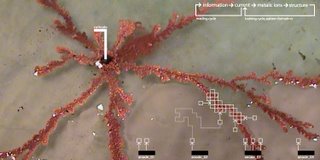Emergence
Complex patterns and behaviours produced from networks of simple interacting processes.
Harnessing emergence for creativity, "intelligence", surprise, wonder and incomprehension.
Emergence in multiple interactive time based processes, micro to macro.
Digital, biological, electrochemical, societal and perhaps even cultural (meme?)
Experimental Emergence:

Dendrite
Army of Clerks
 SmartStudio Interactive Institute Sweden
SmartStudio Interactive Institute Sweden
(home of the mind reading brainball!)
Brainball is a game where you compete in relaxation. The players' brainwaves control a ball on a table, and the more relaxed scores a goal over the opponent. | view project
Computing for Emergent Architecture
From the Bartlett Weblog:
Comment Wall:

Comment Wall is a wall where people can write their thoughts directly onto a wall using their fingers. The camera-recognition system remembers their text and displays it over time. The further away you stand from the wall; the most distant texts are displayed. As you come forward, more and more recent texts are uncovered until, when you are in front of the wall itself, a blank area is created for you to write your own.
Unreal Art - prints generated from Unreal game bots

www.unrealart.co.uk
From the artist PaulStGeorge - who also makes minumental sculptures...
Shockwave example using Conways game of Life to generate designs:

Electrochemical and evolving systems:
Extract from:
Towards Epistemically Autonomous Robots: Exploiting the Potential of Physical Systems
Jon Bird, Paul Layzell, Andy Webster and Phil Husbands
The sculptor and theorist Ken Rinaldo has surveyed the use of artificial life (ALife) techniques in the arts and argues that the greatest potential for their application lies in developing interactive artworks that go “beyond the hackneyed replicable paths of interactivity that have thus far been presented by the arts community” [1].
Rinaldo’s vision is of a “cybernetic ballet of experience, with the machine and human involved in a grand dance of each sensing and responding to the other,” which will result in “sculptural and virtual algorithmic manifestations that will far surpass our wildest imaginations.”
Motivating this vision is what Mitchell Whitelaw has identified as an essential driving force in contemporary ALife art: the “will to escape, the desire for emergence” [2].
1. Kenneth E. Rinaldo, “Technology Recapitulates Phylogeny:
Artificial Life Art,” Leonardo 31, No. 5, 371--376 (1998).
2. Mitchell Whitelaw, “Tom Ray’s Hammer: Emergence and Excess in
ALife Art,” Leonardo 31, No. 5, 377--381 (1998).
Harnessing emergence for creativity, "intelligence", surprise, wonder and incomprehension.
Emergence in multiple interactive time based processes, micro to macro.
Digital, biological, electrochemical, societal and perhaps even cultural (meme?)
Experimental Emergence:

Dendrite
Army of Clerks
Dendrite is a simple computation device based on electro-deposition. Information in the form of electric impulses controls the formation of metallic threads in a metallic salt solution, which in return modify the way that information flows through them: the longer the thread between two points (a cathode and any of the anodes), the smaller the electric resistance and the reduction of the signal between them.
| ||||||||||||||||||||||||||
Associated with:
 SmartStudio Interactive Institute Sweden
SmartStudio Interactive Institute Sweden(home of the mind reading brainball!)
Brainball is a game where you compete in relaxation. The players' brainwaves control a ball on a table, and the more relaxed scores a goal over the opponent. | view project
Computing for Emergent Architecture
From the Bartlett Weblog:
Comment Wall:

Comment Wall is a wall where people can write their thoughts directly onto a wall using their fingers. The camera-recognition system remembers their text and displays it over time. The further away you stand from the wall; the most distant texts are displayed. As you come forward, more and more recent texts are uncovered until, when you are in front of the wall itself, a blank area is created for you to write your own.
Unreal Art - prints generated from Unreal game bots

www.unrealart.co.uk
From the artist PaulStGeorge - who also makes minumental sculptures...
Shockwave example using Conways game of Life to generate designs:

Electrochemical and evolving systems:
Extract from:
Towards Epistemically Autonomous Robots: Exploiting the Potential of Physical Systems
Jon Bird, Paul Layzell, Andy Webster and Phil Husbands
The sculptor and theorist Ken Rinaldo has surveyed the use of artificial life (ALife) techniques in the arts and argues that the greatest potential for their application lies in developing interactive artworks that go “beyond the hackneyed replicable paths of interactivity that have thus far been presented by the arts community” [1].
Rinaldo’s vision is of a “cybernetic ballet of experience, with the machine and human involved in a grand dance of each sensing and responding to the other,” which will result in “sculptural and virtual algorithmic manifestations that will far surpass our wildest imaginations.”
Motivating this vision is what Mitchell Whitelaw has identified as an essential driving force in contemporary ALife art: the “will to escape, the desire for emergence” [2].
1. Kenneth E. Rinaldo, “Technology Recapitulates Phylogeny:
Artificial Life Art,” Leonardo 31, No. 5, 371--376 (1998).
2. Mitchell Whitelaw, “Tom Ray’s Hammer: Emergence and Excess in
ALife Art,” Leonardo 31, No. 5, 377--381 (1998).

0 Comments:
Post a Comment
<< Home